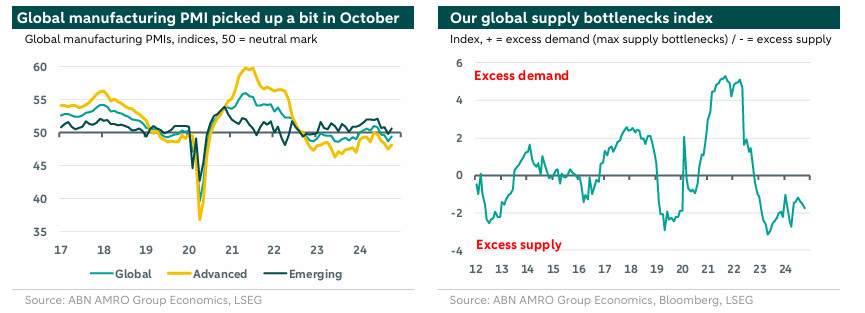Global manufacturing PMI shows some improvement


Global manufacturing PMI shows first improvement in five months, still in contraction mode. Global excess supply conditions continue, which helps keep a lid on global goods' price pressures.
Global manufacturing PMI shows first improvement in five months, still in contraction mode
After having fallen since May 2024 for four consecutive months, the global manufacturing PMI showed some improvement in October, rising to 49.4 (September: 48.7) though remaining below the neutral mark separating expansion from contraction. In terms of geography, the improvement was quite broad-based, with the aggregate indices for both developed and emerging economies rising. The improvement seems to be in sync with the start of the easing cycles in key economies such as the US, China and the eurozone seen over the past few months (see our earlier comments on global manufacturing ).
Emerging markets (EM) continue to do better than developed markets (DM) in terms of manufacturing. The aggregate EM index rose back to above the neutral mark (50.6, September: 49.8). This improvement was driven by China (see our earlier comment ) and India. Meanwhile, the aggregate DM index rose to 48.1 (September: 47.5), but remained clearly in contraction territory. Amongst DMs, there were some improvements for the US (Markit, not ISM), and the eurozone. The manufacturing PMI for the eurozone picked up for the first time since May, rising to 46.0 (September: 45.0), so still well below the 50 mark (also see ). This improvement was driven by Germany (rise of 2.4 points to 43.0), although Germany’s manufacturing PMI remains the lowest within the eurozone. The index for the Netherlands fell to a ten-month low of 47.0 (September: 48.2), see our earlier comment .
Global excess supply conditions continue …
The subcomponents of the global manufacturing PMI show that both the supply side and the demand side improved, but the supply side remains stronger. The global output component rose to 50.1 (September: 49.2) driven by EMs. The global subindices for new orders and export orders also rose significantly in October, but remained in contraction territory. These developments are also still visible in our global supply bottlenecks index, for which an excess supply/demand metric is one of the key components. Our global supply bottlenecks index moved a bit further into “excess supply” territory in October.
… which helps keep a lid on global goods’ price pressures
The ongoing global excess supply conditions help keep a lid on cost push price pressures stemming from global manufacturing. The global PMI component for input prices remained at relatively low levels in October (53.2), well below the peaks seen during the pandemic episode of abundant supply bottlenecks in 2021-2022. The same is true for the output prices’ component (October: 51.4). That said, there are some developments that need close watching. After having dropped back sharply in July-October following a geopolitical risk driven spike in Q2-2024, spot container tariffs have shown an uptick again over the past few weeks. This recent uptick was driven by China-Europe container prices (up 26% since 24 October), although these also had fallen sharper compared to China-US tariffs in the months before.
